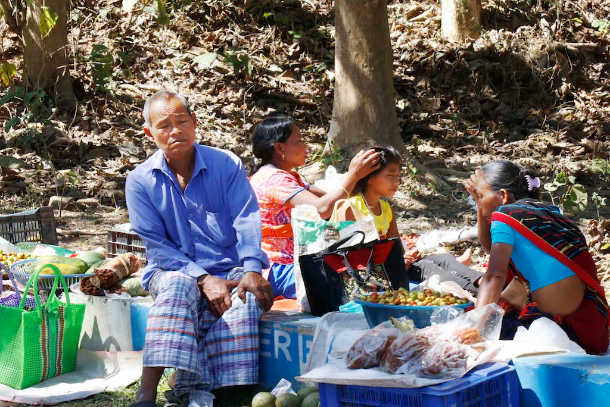
Indigenous people sell their produce in Rangamati district of Chittagong Hill Tracts of Bangladesh on March 2. The restive region has seen 58 people killed amid rivalry between regional political parties since 2017. (Photo by Stephan Uttom/ucanews.com)
Two shooting incidents in the restive Chittagong Hill Tracts (CHT) region of southeast Bangladesh have left eight people dead.
Unidentified gunmen sprayed bullets on two jeeps carrying polling officials escorted by a member of Ansar, a paramilitary security force, in Baghaichhari subdistrict of Rangamati district on March 18.
Four people died on the spot, another three died in a local hospital and several others are still hospitalized. The victims were ambushed while returning to the district headquarters in Rangamati after voting ended for a subdistrict council election.
In the second attack on the morning of March 19, unknown gunmen shot dead a top leader from the local unit of the ruling Awami League party in front of his residence in Bilaichhari subdistrict in Rangamati.
No one has claimed responsibility for the attacks.
“No case has been filed yet over the attacks, but we are investigating who perpetrated the violence,” Abdul Monjur, officer in charge of Baghaichhari police station, told ucanews.com.
However, the latest attacks are seen as a continuation of the bloodletting rivalry between armed ethnic indigenous political parties in the CHT that has seen 58 people murdered in 15 months since December 2017.
The violence is a result of political instability and grievances among ethnic groups, said Holy Cross Father Liton Hubert Gomes, secretary of the Catholic Bishops’ Justice and Peace Commission.
“The CHT has been a restive region for years and it continues to be a volatile zone despite the signing of a peace accord in 1997 between the government and ethnic militias. The peace treaty has not been properly implemented and ethnic groups are venting their anger for what they see playing out over the promises made,” Father Gomes told ucanews.com.
“To establish peace on the hills, we need to ensure a true democratic system and the rights of everyone sustained. All parties need to be patient, practice restraint and denounce dominating attitudes.”
Sazzad Hossain Siddiqui, associate professor of peace and conflict studies at Dhaka University, told ucanews.com that the CHT has seen various dimensions of a divide-and-rule policy starting from the Pakistan period to an independent Bangladesh.
“Ethnic groups used to be united and opposed Bengali rule, but today they are divided into at least four groups. The peace treaty has been dormant, so there is no peace on the hills in the true sense,” he said.
“The government needs to be wise in handling people in the CHT. Land disputes must be resolved and military camps should be withdrawn. All kinds of efforts are needed to dissipate anger among the people of the hills.”
Grievances in neglected region
The CHT comprising three hilly and forested districts — Bandarban, Rangamati and Khagrachhari — is the only mountainous region of Bangladesh and borders India and Myanmar. The region is home to more than 25 ethnic indigenous groups, mostly Buddhists.
In the 1960s, when Bangladesh was part of Pakistan, trouble erupted in the CHT after the launch of an artificial lake for a hydropower plant in Rangamati that submerged vast areas and displaced thousands of people.
Unrest increased after Bangladesh gained independence in 1971. People in the hills remained largely neglected and aggrieved and formed a political party, Parbatya Chattagram Jana Samhati Samiti (PCJSS).
Since the late 1970s, the government has tried to change the demography of the region by transferring poor and landless Bengali Muslims there. Muslim settlers occupied land and property of indigenous people with backing from state officials.
To resist settlers, the PCJSS formed an armed militia, Shanti Bahini (Peace Force), and started attacking Muslims and government forces.
In response, the government militarized the region and a bush war ensued between the military and the militia for nearly two decades.
In 1997, the government and the PCJSS signed a peace accord that focused among others land dispute resolution, regional autonomy, socioeconomic development and the withdrawal of military camps.
A PCJSS faction that opposed the peace treaty formed another political party, the United People’s Democratic Front, to seek full autonomy for the CHT.
The land dispute remains unresolved and the CHT is still heavily militarized after an increase in violence since 2017.


